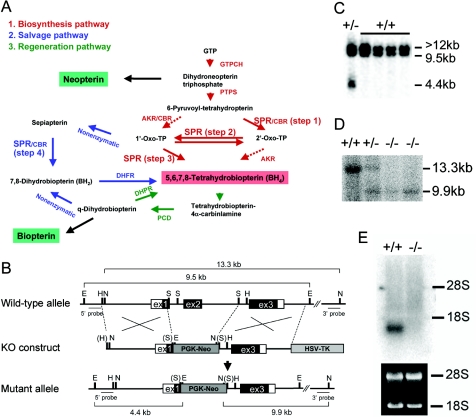Figure 1.
Biosynthesis of BH4 and generation of Spr-knockout mice. A, Biosynthesis of BH4, including the possible alternative pathways (dashed arrows). B, Mouse Spr genomic structure (wild-type), the knockout (KO) construct, and the resulting targeted mutant allele. The Spr gene consists of three exons. Blackened and unblackened boxes represent exons that encode translated and untranslated regions of SPR, respectively. Restriction-enzyme sites for EcoRI (E), HindIII (H), NcoI (N), and SacI (S) are indicated. Restriction-enzyme sites in parentheses indicate the loss of a recognition sequence during construction of the KO vector. The probes (5′ probe and 3′ probe) for Southern-blot analysis and the expected sizes of fragments from wild-type and mutant Spr loci are shown. To construct the targeting vector, a segment from exon 1 and the entire exon 2 region were replaced with the PGK-neomycin resistance cassette (PGK-Neo). The herpes simplex virus–thymidine kinase cassette (HSV-TK) was inserted at the 3′ end of the construct, for negative selection with FIAU. C, Southern-blot analysis of embryonic stem cell clones by use of the 5′ probe. Genomic DNA isolated from embryonic stem cell clones was digested with EcoRI. The 5′ probe detects the Spr pseudogene (>12 kb) as well as the wild-type (9.5 kb) and mutant (4.4 kb) bands in the authentic Spr locus. D, Southern-blot analysis of pups from Spr+/− matings by use of the 3′ probe. Genomic DNA from pups was digested with NcoI. Southern-blot analysis using the authentic Spr gene-specific 3′ probe showed 13.3-kb and 9.9-kb bands for the wild-type and mutant alleles, respectively. E, Northern-blot analysis showing no detectable Spr transcript in the kidney of Spr−/− mice.

